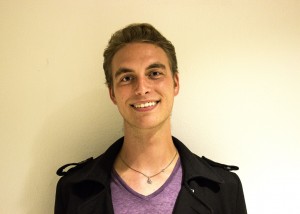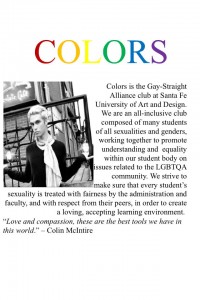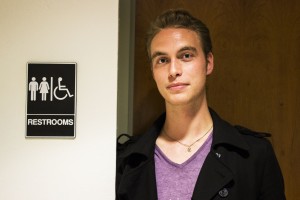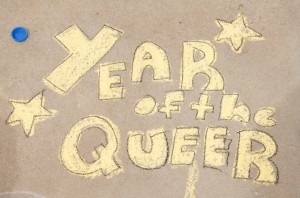Tags
Related Posts
Share This
Colors’ Spectrum

Colin McIntire has made it his mission to fight for his and the L.G.B.T community’s rights. Photo by Sandra Schoenenstein
“I was about to kill myself. And in a split second I told myself, ‘OK…you could end it now, or you can fight for yourself—and if you fight, you have to fight for yourself and other people for the rest of your life.”
This was the defining moment for Colin McIntire, and his reason, he says, for starting Colors.
“Colors is a safe haven,” McIntire says—and also happens to be the gay-straight alliance at the Santa Fe University of Art and Design. Founded during the College of Santa Fe era, the alliance was re-established in the fall of 2013 by McIntire and alum Kyle Reich. As Colors’ president, McIntire says the alliance “strives to create a community in which…anyone—lesbian, gay, bisexual, transgender, transsexual, queer or straight,” can come together and promote “education, learn from one another and create a safe environment.”
A lack of safety and community is common for the LGBT youth.
In fact, challenges LGBT youth face, according to a 2013 survey of more than 10,000 LGBT teens, is directly related to their sexuality.
Sponsored and published by the Human Rights Campaign—the nation’s largest lesbian, gay, bisexual and transgender civil rights organization—the survey also says, “social ostracism leaves LGBT youth disaffected and disconnected in their own homes and neighborhoods.”
Familiar with this feeling, McIntire says, “I was not supported by my parents,” in fact, “I was shunned by them.”

McIntire’s goal is to provide a safe haven for students and to promote equality and understanding within the student community. Photo courtesy of Colors.
McIntire grew up in Oklahoma City, OK, where “Being gay,” he says, “is a little more difficult than in other places because you have that wonderful mixture of the Midwest and the South right in one state.”
McIntire came out of the closet his sophomore year of high school, but went right back in after his parents sent him to Exodus International—an organization notorious for its “reparative therapy.” Exodus thought, as did some parents from whom Exodus solicited its “patients,” that homosexuality was an illness that could be cured through a disciplined regiment of prayer and therapy—the details of which are too chilling for McIntire to recall. Exodus closed its doors in June 2013 due to a change in public opinion about its methods.
“Growing up knowing I was gay was incredibly difficult, but it’s certainly OK now,” McIntire says, smiling.
The summer between his junior and senior year of high school, when he was 17, McIntire came out of the closet again, and never looked back. Nor does he plan on returning, he says, having since come to terms with his sexuality—which for McIntire is “more than just who we want to have sex with, it’s who we’re drawn to.”
McIntire, his officers and Colors’ members are tireless in their advocacy efforts for the LGBT community. At the moment, preparations are in the works for Pride Week—which will occur in the 2015 spring semester and feature safe sex seminars, free HIV testing, a dance, Olympic games and possibly a speech by Javier Gonzales—Santa Fe’s first openly gay mayor.
Colors’ advocacy, however, is not limited to campus events. With the help of faculty sponsors Mary Beth Lindsey, Malcolm Morgan and Ryan Henson, Colors’ managed to convince administration to create gender-neutral facilities, i.e., a residence hall in St. Michael’s dormitory, and bathrooms in Benildus Hall.
“Gender neutral facilities are important because they’re safe places,” says Olivia Taylor—secretary of Colors.

With the help of faculty sponsors Mary Beth Lindsey, Malcolm Morgan and Ryan Henson, Colors managed to create gender-neutral facilities on campus. Photo by Sandra Schoenenstein
“For students who are transgender or gender neutral,” she says, “daily routines like going to the bathroom can be stressful or emotional unsettling, [so] having gender neutral facilities helps.”
Though McIntire is now relatively assured of his sexuality, he recognizes this may not be the case with others saying, “Sexuality is a spectrum of which we have yet to fully understand.” As a result, Colors does not pressure anyone who may be unsure of what they want to join the alliance, and instead, relies on word-of-mouth and social media.
“I joined Colors because…I saw people in the LGBT community being shunned or bullied,” Taylor says, and, “I was always taught that people are people are people…no matter what race, gender or sexuality they are, they deserve respect and love.”
When LGBT teens were asked, in the Campaign’s survey, to “describe one thing in their lives they would like to change right now,” the No.1 response was to diminish a prevalent misunderstanding, intolerance and hatred of the LGBT community.
Teens, says the Campaign, will be safer, healthier and lead more fulfilling lives only when “the country fully embraces young people regardless of their sexual orientation or gender identity.”
McIntire agrees adding, “We’re progressing in leaps and bounds, and it seems every single day the ignorant population decreases, and people are starting to understand.” After a moment of contemplation, he says, “We just need to keep up momentum.”

The lack of safety and community has always been an issue for the LGBT youth. But this is exactly what Colors is trying to change. Photo courtesy of Colors.






 Jackalope Magazine is the student magazine of Santa Fe University of Art and Design. Building on the interdisciplinary nature of our education, we aim to showcase the talent of our university and character of our city.
Jackalope Magazine is the student magazine of Santa Fe University of Art and Design. Building on the interdisciplinary nature of our education, we aim to showcase the talent of our university and character of our city.
Recent Comments